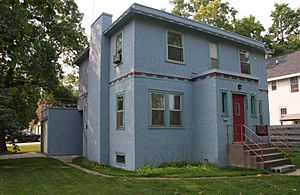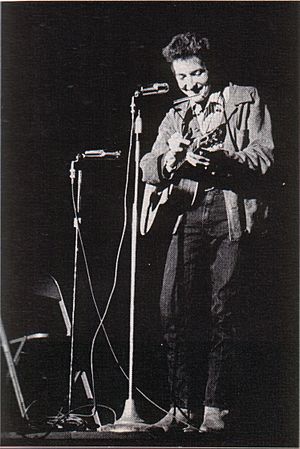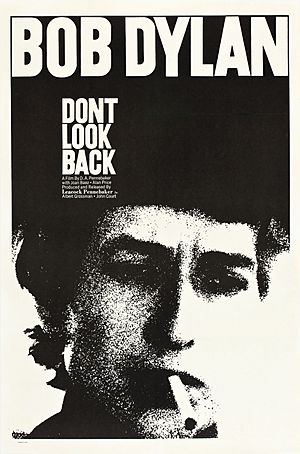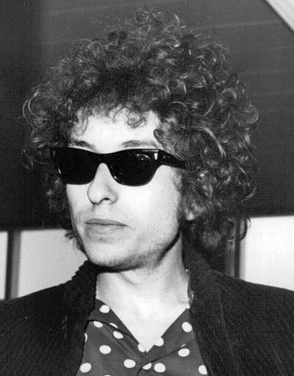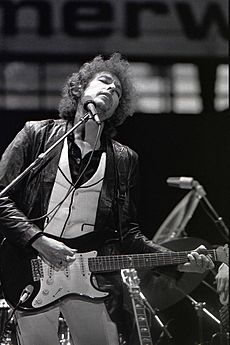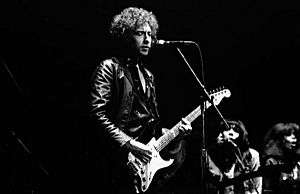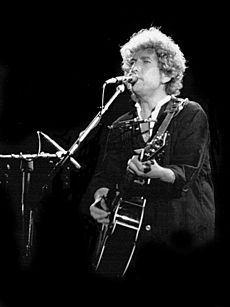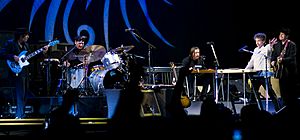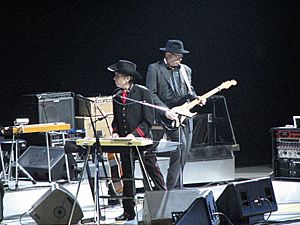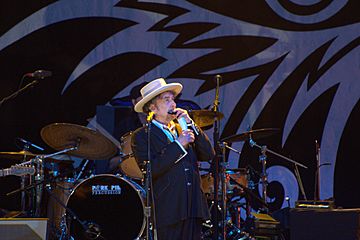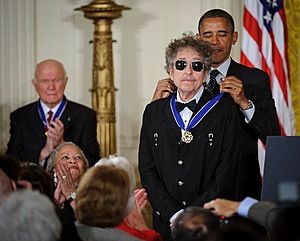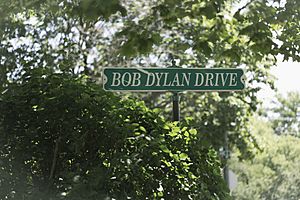Bob Dylan facts for kids
Quick facts for kids
Bob Dylan
|
|
|---|---|
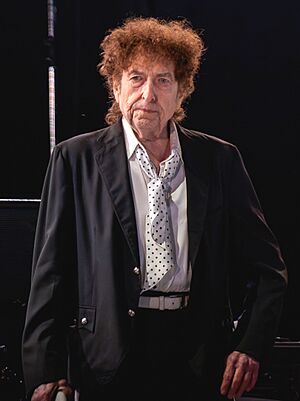
Dylan in 2019
|
|
| Born |
Robert Allen Zimmerman
May 24, 1941 Duluth, Minnesota, U.S.
|
| Other names |
|
| Occupation |
|
| Years active | 1957–present |
| Spouse(s) |
Sara Lownds
(m. 1965; div. 1977)Carolyn Dennis
(m. 1986; div. 1992) |
| Children | 6, including Jesse and Jakob |
| Awards |
|
| Musical career | |
| Genres | |
| Instruments |
|
| Labels |
|
| Signature | |
 |
|
Bob Dylan (born Robert Allen Zimmerman, May 24, 1941) is a famous American singer and songwriter. Many people consider him one of the greatest songwriters ever. Dylan has been a huge part of popular culture for over 68 years. He has sold around 125 million records worldwide, making him one of the best-selling musicians.
In the early 1960s, Dylan added complex and thoughtful lyrics to folk music. His songs included ideas about politics, society, and philosophy. They were different from typical pop music and appealed to the growing youth movement of the 1960s.
Dylan was born in Minnesota and moved to New York City in 1961 to start his music career. After his first album in 1962, he released The Freewheelin' Bob Dylan (1963). This album included popular songs like "Girl from the North Country" and "A Hard Rain's a-Gonna Fall". His songs "Blowin' in the Wind" (1963) and "The Times They Are a-Changin'" (1964) became important songs for the civil rights movement and the movement against the Vietnam War.
In 1965 and 1966, Dylan surprised many folk music fans by using electric rock instruments. He did this on his albums Bringing It All Back Home, Highway 61 Revisited (both 1965), and Blonde on Blonde (1966). His long song "Like a Rolling Stone" (1965) changed what was possible in popular music.
In July 1966, Dylan had a motorcycle accident and stopped touring for seven years. During this time, he recorded many songs with members of the Band. These recordings later became the album The Basement Tapes (1975). Dylan explored country music on albums like John Wesley Harding (1967) and Nashville Skyline (1969). He received praise for Blood on the Tracks (1975) and Time Out of Mind (1997). The latter won him a Grammy Award for Album of the Year.
Dylan still releases music and has been touring almost constantly since the late 1980s. This tour is known as the Never Ending Tour. Since 1994, Dylan has also published ten books of his paintings and drawings. His artwork has been shown in major art galleries. His life has been featured in documentaries and a movie called A Complete Unknown (2024).
Dylan has received many awards, including an Academy Award, ten Grammy Awards, and a Golden Globe Award. He was honored with the Kennedy Center Honors in 1997 and the Presidential Medal of Freedom in 2012. He is in the Rock and Roll Hall of Fame and the Songwriters Hall of Fame. In 2008, he received a special Pulitzer Prize. In 2016, he won the 2016 Nobel Prize in Literature for creating "new poetic expressions within the great American song tradition".
Contents
- Early Life and Musical Beginnings
- Music Career Highlights
- Moving to New York and Early Success
- Protest Music and New Directions
- Going Electric and a Break from Touring
- 1970s: Touring and Christian Music
- 1980s: Changing Sounds and Collaborations
- 1990s: Return to Folk and Resurgence
- 2000s: Awards, Memoirs, and Radio Show
- 2010s: New Albums and Nobel Prize
- 2020s: New Music and Continued Legacy
- The Never Ending Tour
- Personal Life
- Awards and Honors
- Legacy and Influence
- Archives and Recognition
- Visual Arts
- Written Works
- Discography
- See also
Early Life and Musical Beginnings
Bob Dylan was born Robert Allen Zimmerman in Duluth, Minnesota, on May 24, 1941. His family was part of a small Jewish community. His grandparents came to the United States from Eastern Europe to escape difficult times for Jewish people.
Dylan's family lived in Duluth until he was six. Then, his father became ill, and they moved to Hibbing, Minnesota. His father and uncles ran a furniture and appliance store there.
In the early 1950s, Dylan listened to the Grand Ole Opry radio show. He loved the songs of Hank Williams. He also enjoyed the singing style of Johnnie Ray. As a teenager, Dylan listened to rock and roll music on the radio.
Dylan formed several bands while in Hibbing High School. With his band, the Golden Chords, he played songs by Little Richard and Elvis Presley. Once, their performance was so loud that the principal turned off their microphone! In 1959, Dylan saw Buddy Holly perform just days before Holly's plane crash. Dylan was very inspired by Holly's songs and singing.
In September 1959, Dylan started college at the University of Minnesota. He began performing at coffeehouses near campus. He became interested in American folk music instead of rock and roll. He felt folk music was more serious and reflected deeper feelings. During this time, he started calling himself "Bob Dylan." He liked the name after seeing poems by Dylan Thomas.
Music Career Highlights
Moving to New York and Early Success
Dylan left college in May 1960. In January 1961, he moved to New York City to pursue music. He also wanted to visit his musical hero, Woody Guthrie, who was in a hospital. Guthrie's songs greatly influenced Dylan's early music. Dylan also learned from blues musician Robert Johnson and country singer Hank Williams.
Starting in February 1961, Dylan played in clubs around Greenwich Village. He learned from other folk singers like Dave Van Ronk and Odetta. In September, a newspaper critic named Robert Shelton wrote a very positive review of Dylan's performance. This helped Dylan get noticed.
Soon after, producer John Hammond signed Dylan to Columbia Records. Dylan's first album, Bob Dylan, came out on March 19, 1962. It mostly featured traditional folk and blues songs. It only had two original songs by Dylan.
On August 9, 1962, Dylan legally changed his name to Robert Dylan. That same month, he signed with manager Albert Grossman. Grossman was known for being very protective of Dylan.
Dylan visited the United Kingdom in late 1962 and early 1963. He appeared on a BBC television show and performed "Blowin' in the Wind". While in London, he played in folk clubs and learned new songs from British performers.
His second album, The Freewheelin' Bob Dylan, was released in May 1963. This album made him famous as a singer-songwriter. Many songs on the album were protest songs. "Oxford Town" was about James Meredith, the first Black student at the University of Mississippi. "Blowin' in the Wind" questioned society and became a hit for other artists like Peter, Paul, and Mary.
"A Hard Rain's a-Gonna Fall" was based on an old folk song. Its serious message felt very important when the Cuban Missile Crisis happened. These songs showed a new way of writing lyrics, mixing deep thoughts with traditional folk styles.
People saw Dylan as more than just a songwriter. One writer said he became "the voice of his generation." He understood how young Americans felt about peace and civil rights. The album also had love songs and funny songs. Even the Beatles loved Freewheelin'. George Harrison said it was "incredibly original and wonderful."
Some people found Dylan's singing voice a bit rough. But many others loved it. Author Joyce Carol Oates said his voice was "dramatic and electrifying." Many of Dylan's early songs became popular when other artists sang them. Joan Baez helped Dylan become famous by singing his songs and inviting him to perform with her.
Protest Music and New Directions
In May 1963, Dylan's political standing grew. He walked off The Ed Sullivan Show because CBS television wanted to censor his song "Talkin' John Birch Paranoid Blues". Dylan refused to change his song.
Dylan and Joan Baez were important figures in the civil rights movement. They sang together at the March on Washington for Jobs and Freedom in August 1963. Dylan performed "Only a Pawn in Their Game" and "When the Ship Comes In".
Dylan's third album, The Times They Are a-Changin', showed his more political side. Songs like "Only a Pawn in Their Game" were about current events. It addressed the murder of civil rights worker Medgar Evers. "The Lonesome Death of Hattie Carroll" was about the death of a Black hotel worker.
By late 1963, Dylan felt controlled by the folk and protest movements. He felt pressured to be a certain kind of artist.
Johnny Cash supported Dylan's choice to be himself. Cash wrote a letter saying, "Shut up! And let him sing!" Cash and Dylan became friends after meeting at the Newport Folk Festival in July 1964.
Another Side of Bob Dylan, recorded in one evening in June 1964, had a lighter feel. It showed Dylan's humorous side again. Songs like "Spanish Harlem Incident" and "To Ramona" were love songs. "It Ain't Me Babe" seemed to reject the idea of him being a political spokesperson.
Two longer songs showed his new direction. "Chimes of Freedom" used vivid images to comment on society. "My Back Pages" criticized his own earlier serious protest songs.
In late 1964 and early 1965, Dylan changed from a folk songwriter to a rock star. His style changed, and he started to challenge interviewers.
Going Electric and a Break from Touring
Dylan's album Bringing It All Back Home, released in March 1965, was a big change. It was his first album with electric instruments. The song "Subterranean Homesick Blues" was like early rap music. It had a unique music video where Dylan threw cue cards with lyrics on the ground. This video was part of the film Dont Look Back.
The second side of Bringing It All Back Home had four long acoustic songs. "Mr. Tambourine Man" became very famous when The Byrds recorded an electric version.
In 1965, Dylan performed at the Newport Folk Festival. He played an electric set for the first time since high school. This caused a lot of discussion among folk music fans. Some people cheered, but others booed because he was using electric instruments. This event is known as the Electric Dylan controversy.
After Newport, Dylan recorded "Positively 4th Street". Its lyrics seemed to be a message to former friends from the folk community.
Highway 61 Revisited and Blonde on Blonde In July 1965, Dylan's song "Like a Rolling Stone" became a huge hit. It reached number two on the US chart. Rolling Stone magazine later called it the number one song of all time. Bruce Springsteen said the song "sounded like somebody'd kicked open the door to your mind."
The song was the first on Dylan's next album, Highway 61 Revisited. The album was named after a road that connected Dylan's home in Minnesota to the musical city of New Orleans. The songs had a blues-rock sound. "Desolation Row" was a long, acoustic song that mentioned many figures from history and culture.
Dylan toured the US and Canada for six months starting in September 1965. He was backed by five musicians who became known as the Band. While audiences became more accepting, their studio recordings were difficult. Producer Bob Johnston convinced Dylan to record in Nashville in February 1966. They recorded the double album Blonde on Blonde (1966). Dylan called its sound "thin wild mercury."
On November 22, 1965, Dylan quietly married Sara Lownds. They had four children together, and Dylan adopted Sara's daughter from a previous marriage.
Dylan toured Australia and Europe in April and May 1966. Each show had two parts: an acoustic solo set and an electric set with the Hawks. This difference upset some fans, who booed. A famous moment happened at a concert in Manchester, England. A fan shouted "Judas!" at Dylan, who replied, "I don't believe you... You're a liar!" Then he told his band, "Play it loud!"
During his 1966 tour, Dylan was very tired and overwhelmed. He later said he was "on the road for almost five years. It wore me down."
On July 29, 1966, Dylan had a motorcycle accident near his home in Woodstock, New York. The details are not fully clear, but Dylan said he broke bones in his neck. Biographers say the crash gave him a chance to step away from the pressures of fame. He made very few public appearances and did not tour again for almost eight years.
While recovering, Dylan edited a film of his 1966 tour. He also recorded over 100 songs in 1967 with the Hawks. These songs were later released as The Basement Tapes in 1975.
In late 1967, Dylan returned to recording in Nashville. He made John Wesley Harding, an album with short songs about the American West and the Bible. It was different from his earlier work. It included "All Along the Watchtower", which Jimi Hendrix famously covered.
Nashville Skyline (1969) featured Nashville musicians and a softer singing voice from Dylan. It included a duet with Johnny Cash and the popular song "Lay Lady Lay". This album helped shape the new genre of country rock.
In May 1969, Dylan appeared on The Johnny Cash Show. He sang a duet with Cash and performed solo songs. Dylan also played at the Isle of Wight Festival in England in August 1969.
1970s: Touring and Christian Music
In the early 1970s, some critics felt Dylan's music was unpredictable. His album Self Portrait (1970) received mixed reviews. However, New Morning (1970) was seen as a return to his strong songwriting.
Dylan's book of prose-poetry, Tarantula, was published in 1971. It received negative reviews at first.
In 1972, Dylan joined the film Pat Garrett and Billy the Kid. He wrote the soundtrack and played a character named "Alias." The song "Knockin' on Heaven's Door" from the film became one of his most covered songs.
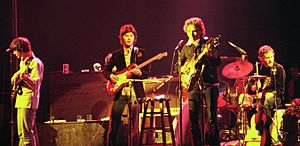
In 1973, Dylan signed with a new record label, Asylum Records. His album Planet Waves was recorded with the Band. It included two versions of "Forever Young", a very popular song. Dylan said he wrote it thinking about his son.
In January 1974, Dylan and the Band went on a big North American tour. It was his first tour in seven years. A live album from the tour, Before the Flood, was released. Dylan later returned to Columbia Records.
After the tour, Dylan and his wife faced challenges in their marriage. He wrote songs about relationships, which became the album Blood on the Tracks (1975). Critics later called it one of Dylan's best albums.
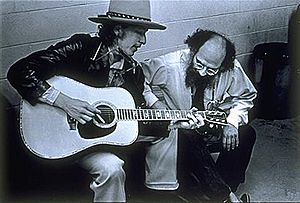
In 1975, Dylan supported boxer Rubin "Hurricane" Carter, who was in prison. Dylan wrote the song "Hurricane" to argue for Carter's innocence. He performed it on his next tour, the Rolling Thunder Revue. This tour featured many musicians and artists from the folk scene. The album Desire was released during this tour.
The 1975 tour was also the setting for Dylan's film Renaldo and Clara. The film mixed concert footage with fictional stories. It received negative reviews.
In 1978, Dylan went on a year-long world tour. He performed 114 shows for two million people. Live recordings from his Tokyo concerts were released as Bob Dylan at Budokan. The tour earned a lot of money. Dylan also recorded the album Street-Legal (1978).
In the late 1970s, Dylan became a Christian. He released three albums of gospel music. Slow Train Coming (1979) featured guitarist Mark Knopfler. Dylan won a Grammy Award for Best Male Rock Vocal Performance for the song "Gotta Serve Somebody". When he toured, he only played his new Christian songs. He also spoke about his faith from the stage.
Some fans and musicians did not like Dylan's new Christian focus. However, Stephen Holden wrote that Dylan's faith had not changed his unique personality.
1980s: Changing Sounds and Collaborations
In late 1980, Dylan started playing his popular 1960s songs again in concerts. His second Christian album, Saved (1980), received mixed reviews. His third Christian album was Shot of Love (1981). This album included his first non-Christian songs in over two years.
Dylan's albums in the 1980s had mixed reactions. Infidels (1983) was produced by Mark Knopfler. It included songs like "Blind Willie McTell", which honored the blues musician and Black American history.
In 1985, Dylan sang on the charity single "We Are the World" for famine relief. He also joined Artists United Against Apartheid for their song "Sun City". On July 13, 1985, he performed at the Live Aid concert in Philadelphia. He spoke about helping farmers with their mortgages, which led to the Farm Aid concert.
In October 1985, Dylan released Biograph, a box set of 53 songs, including many unreleased ones. This set helped establish the idea of box sets in rock music.
Dylan's album Knocked Out Loaded (1986) included cover songs and collaborations. It was his first album since 1962 not to make the Top 50 charts.
In 1986 and 1987, Dylan toured with Tom Petty and the Heartbreakers. He also toured with the Grateful Dead in 1987, which resulted in the live album Dylan & The Dead.
Dylan started what became known as the Never Ending Tour on June 7, 1988. He has been touring with a small, changing band ever since. In 1987, Dylan starred in the movie Hearts of Fire, which was not successful.
Dylan was inducted into the Rock and Roll Hall of Fame in January 1988. Bruce Springsteen said Dylan "freed your mind the way Elvis freed your body."
His album Down in the Groove (1988) sold poorly. However, Dylan then found success with the Traveling Wilburys. This was a supergroup he formed with George Harrison, Jeff Lynne, Roy Orbison, and Tom Petty. Their album Traveling Wilburys Vol. 1 (1988) was very popular.
Dylan ended the 1980s with the highly praised album Oh Mercy (1989). Critics called it one of his best albums of the decade.
1990s: Return to Folk and Resurgence
Dylan's 1990s began with Under the Red Sky (1990), which received negative reviews. Musicians like George Harrison and Elton John played on the album.
In February 1991, Dylan received a Grammy Lifetime Achievement Award. He played "Masters of War" and gave a short speech about finding his way. On October 16, 1992, a concert called "Bobfest" celebrated Dylan's 30th anniversary. Many famous artists performed.
Over the next few years, Dylan returned to his folk roots. He released two albums of traditional folk and blues songs: Good as I Been to You (1992) and World Gone Wrong (1993). He played only with his acoustic guitar. In August 1994, he performed at Woodstock '94.
In November 1994, Dylan recorded two live shows for MTV Unplugged. The album included "John Brown", an unreleased song from 1962 about the harsh realities of war.
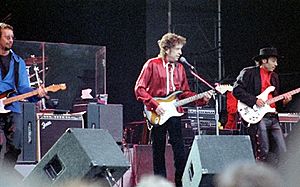
In January 1997, Dylan recorded Time Out of Mind with producer Daniel Lanois. Before the album's release, Dylan was hospitalized with a serious illness. He recovered quickly and joked, "I really thought I'd be seeing Elvis soon." He was back on tour by mid-year. He even performed for Pope John Paul II in Italy.
In September, Time Out of Mind was released. It was highly praised for its deep thoughts about love and life. It won Dylan his first Grammy Award for Album of the Year. The song "Make You Feel My Love" was covered by many artists like Billy Joel and Adele.
2000s: Awards, Memoirs, and Radio Show
In 2001, Dylan won an Academy Award for Best Original Song for "Things Have Changed". He wrote it for the film Wonder Boys.
His album "Love and Theft" was released on September 11, 2001. Dylan produced it himself under the name Jack Frost. Critics noted that he used many musical styles, including rockabilly and jazz. The album won the Grammy Award for Best Contemporary Folk Album.
In 2004, Dylan published the first part of his memoir, Chronicles: Volume One. It focused on his early years in New York City. The book became a bestseller.
Martin Scorsese's documentary No Direction Home was shown in September 2005. It covered Dylan's life from 1961 to 1966. The film included interviews with people who knew him well, and Dylan himself. It won several awards.
Dylan started his weekly radio show, Theme Time Radio Hour, on May 3, 2006. He played songs around a common theme, like "Weather" or "Dreams." He played music from many different artists. His show was praised for its wide range of music and Dylan's stories.
Dylan released Modern Times in August 2006. Critics praised the album, even though Dylan's voice was rougher. It was his first album to reach number one on the US charts since 1976. Modern Times won a Grammy Award for Best Contemporary Folk Album.
In October 2007, Columbia Records released Dylan, a three-CD collection of his entire career. Dylan also appeared in TV advertisements for cars and Pepsi.
The Bootleg Series Vol. 8 – Tell Tale Signs was released in October 2008. It included live performances and unreleased songs. Critics loved it, saying it felt like a new album.
Dylan released Together Through Life on April 28, 2009. Most of the songs were co-written with Robert Hunter. The album received good reviews and reached number one on the US charts. At 67, Dylan became the oldest artist to debut at number one on that chart.
Dylan's Christmas in the Heart was released in October 2009. It featured classic Christmas songs. Dylan donated his earnings from the album to charities that help feed people.
2010s: New Albums and Nobel Prize
The Witmark Demos, Volume 9 of Dylan's Bootleg Series, came out in October 2010. It had 47 demo recordings from 1962 to 1964. Critics praised it as a look at young Bob Dylan changing music.
In April 2011, Bob Dylan in Concert – Brandeis University 1963 was released. It was a live recording from 1963, showing Dylan before he became a huge star.
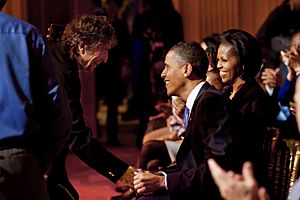
On Dylan's 70th birthday, universities around the world held events to celebrate his work. Fans gathered to honor him.
Dylan's 35th studio album, Tempest, was released on September 11, 2012. It included a song honoring John Lennon and a long song about the sinking of the Titanic. Critics praised Dylan's lyrics on the album.
Volume 10 of Dylan's Bootleg Series, Another Self Portrait (1969–1971), was released in August 2013. It had 35 unreleased songs and live recordings.
In November 2013, Columbia Records released a box set of all 35 of Dylan's studio albums. To promote it, an interactive video for "Like a Rolling Stone" was released.
Dylan appeared in a commercial for the Chrysler 200 car during the 2014 Super Bowl. He talked about American-made cars.
The Lyrics: Since 1962 was published in 2014. This book included different versions of Dylan's songs. A very expensive limited edition was signed by Dylan.
A full collection of the Basement Tapes, The Bootleg Series Vol. 11: The Basement Tapes Complete, was released in November 2014. It had 138 songs and won a Grammy Award.
In February 2015, Dylan released Shadows in the Night. It featured ten classic American songs that Frank Sinatra had recorded. Critics praised Dylan's singing and the simple music. The album reached number one in the UK.
The Bootleg Series Vol. 12: The Cutting Edge 1965–1966 was released in November 2015. It had unreleased material from Dylan's albums Bringing It All Back Home, Highway 61 Revisited, and Blonde on Blonde.
Dylan released Fallen Angels in May 2016. It continued his work of "uncovering" classic American songs. The album had twelve songs by famous songwriters.
The 1966 Live Recordings, including every known recording from Dylan's 1966 tour, was released in November 2016.
Nobel Prize in Literature On October 13, 2016, Dylan was awarded the Nobel Prize in Literature. He won "for having created new poetic expressions within the great American song tradition." He was the first musician to win this award. Dylan remained quiet for days after the announcement. He later said it was "amazing, incredible." His Nobel Lecture was posted online in June 2017.
In March 2017, Dylan released Triplicate, a triple album of 30 more classic American songs. He said it was not about nostalgia but about the songs being timeless.
The next Bootleg Series volume, The Bootleg Series Vol. 13: Trouble No More 1979–1981, looked at his Christian period. It included live performances and showed Dylan's strong belief.
In April 2018, Dylan contributed to Universal Love, an album of wedding songs for the LGBT community. He recorded "She's Funny That Way", changing the words to "He's Funny That Way." That same month, Dylan launched Heaven's Door, a brand of whiskeys.
In November 2018, Dylan released More Blood, More Tracks. This set included all of Dylan's recordings for his album Blood On the Tracks.
In 2019, Netflix released Rolling Thunder Revue: A Bob Dylan Story by Martin Scorsese. It mixed documentary footage with fictional stories. A box set of live recordings from the 1975 tour was released with the film. The next Bootleg Series, Bob Dylan (featuring Johnny Cash) – Travelin' Thru, 1967 – 1969, came out in November 2019. It had unreleased songs with Johnny Cash.
2020s: New Music and Continued Legacy
On March 26, 2020, Dylan released "Murder Most Foul", a 17-minute song about the Kennedy assassination. It became his first song to reach number one on a pop chart. He then released two more new songs, "I Contain Multitudes" and "False Prophet".
Rough and Rowdy Ways, Dylan's 39th studio album, was released on June 19, 2020. It was his first album of new songs since 2012. Critics praised it highly. The album reached number one on the UK album chart. Dylan became the oldest artist to have a number one album of new, original material.
In December 2020, Dylan sold his entire song catalog to Universal Music Publishing Group. This included the rights to over 600 songs.
In February 2021, Columbia Records released 1970, a three-CD set of recordings from his Self Portrait and New Morning sessions. Dylan's 80th birthday was celebrated with a virtual conference and new biographies.
In July 2021, Dylan performed a 50-minute show called Shadow Kingdom: The Early Songs of Bob Dylan. It was filmed in black and white and featured 13 songs. The soundtrack was released in June 2023.
In September 2021, Springtime in New York: The Bootleg Series Vol. 16 (1980–1985) was released. It included rehearsals, live recordings, and unreleased songs from the 1980s.
In July 2022, a special recording of Dylan singing "Blowin' in the Wind" was sold at auction for over $1.7 million. In November, Dylan published The Philosophy of Modern Song, a book of 66 essays about songs by other artists.
In January 2023, Dylan released The Bootleg Series Vol. 17: Fragments – Time Out of Mind Sessions (1996–1997). This set included a remixed version of his 1997 album and unreleased songs. In November 2023, The Complete Budokan 1978 was released, with full recordings from his 1978 Tokyo concerts.
Dylan contributed a cover song, "Don't Fence Me In", to the film Reagan, released in August 2024. In September 2024, The 1974 Live Recordings, a 27-disc set from his 1974 tour, was released.
The Never Ending Tour
The Never Ending Tour began on June 7, 1988. Since then, Dylan has played about 100 concerts each year. This is a very busy schedule for an artist who started in the 1960s. By April 2019, Dylan and his band had played over 3,000 shows.
Dylan's live performances are known for being unpredictable. He often changes his song arrangements and how he sings. Some critics say this is a great way to present his many songs. Others find it hard to recognize his famous lyrics.
In September 2021, Dylan's touring company announced the "Rough and Rowdy Ways World Wide Tour, 2021–2024". This tour featured a more stable set list, with nine of the ten songs from his 2020 album. This tour is seen as a continuation of his Never Ending Tour.
In February 2025, Dylan announced he would join the Outlaw Music Festival 2025 Tour. He will perform with Willie Nelson and other artists. In July 2025, Dylan's company announced the latest part of his Rough and Rowdy Ways world tour. It will start in Helsinki and end in Dublin in late 2025.
One critic said that Dylan's shows cause his songs to change. This means there is no single "perfect" version of a song. Dylan's legacy will be the sum of thousands of performances over many years.
Personal Life
Relationships and Family
Echo Helstrom was Dylan's high school girlfriend. Some believe she inspired his song "Girl from the North Country".
Dylan's first serious relationship was with artist Suze Rotolo. She was photographed with Dylan on the cover of his album The Freewheelin' Bob Dylan. Critics connect Rotolo to some of Dylan's early love songs. Their relationship ended in 1964. Rotolo later wrote a memoir about her time with Dylan.
Joan Baez met Dylan in April 1961. She was already a famous folk singer. Baez was very impressed by Dylan's song "With God on Our Side". In July 1963, Baez invited Dylan to sing with her at the Newport Folk Festival. This led to many duets over the next two years. Their romantic relationship ended around 1965. Baez later toured with Dylan on his Rolling Thunder Revue in 1975–76. She also appeared in his film Renaldo and Clara. Baez wrote about Dylan in her autobiographies. Her song "Diamonds & Rust" is seen as a portrait of Dylan.
Dylan married Sara Lownds on November 22, 1965. They had four children: Jesse, Anna, Samuel, and Jakob. Dylan also adopted Sara's daughter, Maria. Sara Dylan played a role in Dylan's film Renaldo and Clara. Bob and Sara Dylan divorced on June 29, 1977.
Dylan and his backing singer Carolyn Dennis have a daughter, Desiree Gabrielle Dennis-Dylan, born in 1986. They were married in 1986 and divorced in 1992. Their marriage and child were kept private for many years.
Home and Beliefs
When not touring, Dylan mostly lives in Point Dume, California. He also owns property in other places.
Dylan grew up in a Jewish community in Hibbing, Minnesota. He had his bar mitzvah in May 1954.
In the late 1970s, Dylan converted to Christianity. He attended Bible study classes. A pastor recalled that Dylan "prayed that day and received the Lord."
By 1984, Dylan was moving away from the "born again" label. He said he had always believed in a higher power. In 1997, he explained that he finds his religion in music. He said songs like "Let Me Rest on a Peaceful Mountain" are his religion. He believes in the power of songs.
Dylan has supported the Chabad Lubavitch movement, a Jewish group. He has participated in Jewish religious events. He has also appeared on the Chabad telethon.
Dylan continues to perform songs from his gospel albums in concert. He sometimes sings traditional religious songs. He has made comments about his faith. In a 2004 interview, he said the only person you should think twice about lying to is yourself or God. He explained his constant touring as part of a promise he made to a "chief commander."
In December 2022, Dylan said he reads scriptures, meditates, and prays. He believes in good and bad outcomes and in predestination.
Awards and Honors
Dylan is in the Rock and Roll Hall of Fame, Nashville Songwriters Hall of Fame, and Songwriters Hall of Fame. In 1997, US President Bill Clinton gave Dylan a Kennedy Center Honor. Clinton said Dylan had a huge impact on his generation.
In May 2000, Dylan received the Polar Music Prize from Sweden's King Carl XVI. In June 2007, he received the Princess of Asturias Award in the Arts category. The jury called him "a living myth." In 2008, he received a special Pulitzer Prize for his "extraordinary poetic power."
Dylan received the Presidential Medal of Freedom in May 2012. President Barack Obama said Dylan was "a bigger giant in the history of American music." Obama praised Dylan's unique voice and how he changed music's message. In November 2013, Dylan received France's highest honor, the Légion d'Honneur. In February 2015, Dylan received the MusiCares Person of the Year award for his charity and artistic work.
Legacy and Influence
Dylan is seen as one of the most influential people of the 20th century. Time magazine called him a "master poet" and a "guiding spirit of the counterculture generation." Paul Simon said Dylan's early songs were very rich and had strong melodies. He said Dylan "defined the genre for a while."
Many critics believe Dylan's greatest achievement was his albums from the mid-1960s: Bringing It All Back Home, Highway 61 Revisited, and Blonde on Blonde. These albums mixed folk, blues, rock, poetry, and social commentary.
Critics like Michael Gray began to study Dylan's work seriously. They compared his lyrics to famous writers like John Donne and T. S. Eliot. In 2004, Harvard University offered a class called "Dylan." It looked at Dylan's work alongside classical poets like Virgil and Homer.
Literary critic Christopher Ricks wrote a book praising Dylan's work. He said Dylan was a "genius of and with language." The Encyclopædia Britannica called Dylan "the Shakespeare of his generation." Former British poet laureate Andrew Motion said Dylan's lyrics should be studied in schools.
Many of Dylan's lyrics are now famous sayings. Bartlett's Familiar Quotations includes lines like "the times they are a-changin'."
Rolling Stone magazine ranked Dylan first on its list of the 100 Greatest Songwriters of All Time. They also put "Like A Rolling Stone" first on their list of greatest songs. The magazine said his lyrics were the first in rock to be seen as literature.
Dylan's voice also received attention. Early on, it was described as "rusty" and "etched in gravel." As he got older, his voice became rougher but more expressive.
Many musicians have said Dylan influenced them. These include John Lennon, Paul McCartney, Joni Mitchell, Neil Young, Bruce Springsteen, and David Bowie. Dylan also helped the early success of the Byrds and the Band. Johnny Cash called Dylan "the greatest writer of our time."
Some critics have different views. Nik Cohn called Dylan a "minor talent with a major gift for self-hype." Jack Marx said Dylan invented the "arrogant, faux-cerebral posturing" style in rock music.
Joni Mitchell once called Dylan a "plagiarist" and his voice "fake." Dylan responded that using other people's material was "part of the tradition."
Dylan's music has also inspired artists in other fields. Comic book creators Dave Gibbons and Alan Moore were inspired by his song "Desolation Row".
In 2007, Todd Haynes released I'm Not There, a film inspired by Dylan's music and life. Six different actors played different parts of Dylan's personality.
Irish playwright Conor McPherson wrote the musical Girl from the North Country. It used Dylan's songs to tell stories during the Great Depression in Dylan's hometown.
One critic said that while rock and roll might have happened without Elvis Presley, there's no clear reason for Bob Dylan. He became the world's first great rock and roll poet. Then, he created his own folk tradition.
The film A Complete Unknown (2024) showed Dylan's rise to fame from 1961 to 1965. It received good reviews, especially for actor Timothée Chalamet as Dylan.
Archives and Recognition
In March 2016, it was announced that Dylan's archive was sold. It included about 6,000 notebooks, song drafts, recordings, and letters. The Bob Dylan Center in Tulsa, Oklahoma opened in May 2022 to house this archive.
In 2005, 7th Avenue East in Hibbing, Minnesota, where Dylan lived, was given the honorary name Bob Dylan Drive. In 2006, the Bob Dylan Way cultural path opened in Duluth, Minnesota.
In 2015, a large mural of Dylan by artist Eduardo Kobra was unveiled in Minneapolis.
In December 2013, the guitar Dylan played at the 1965 Newport Folk Festival sold for $965,000. In June 2014, Dylan's handwritten lyrics for "Like a Rolling Stone" sold for $2 million. This was a record for a popular music manuscript.
Visual Arts
Painting
Dylan's artwork was first seen on the cover of the Band's Music from Big Pink album in 1968. His own 1970 album Self Portrait also featured his painting. More of his art was shown in his 1973 book Writings and Drawings.
In 1994, a book of Dylan's drawings called Drawn Blank was published. In 2007, his first public art exhibition, The Drawn Blank Series, opened in Germany. It showed over 200 watercolors and gouaches.
In July 2011, a major art gallery, Gagosian Gallery, started showing Dylan's paintings. An exhibition called The Asia Series showed his paintings of scenes in China and the Far East. Some people wondered if his paintings were based on his own experiences or on widely available photographs. The gallery confirmed that Dylan had permission to use the photos.
Dylan's second show at the Gagosian Gallery, Revisionist Art, opened in November 2012. It had thirty paintings that changed and made fun of popular magazines, including (...) and Babytalk. In February 2013, Dylan showed his New Orleans Series paintings in Milan, Italy. In August 2013, Britain's National Portrait Gallery, London hosted Dylan's first major UK exhibition, Face Value, featuring twelve portraits.
In November 2016, the Halcyon Gallery showed Dylan's art in an exhibition called The Beaten Path. It showed American landscapes and city scenes inspired by his travels. In October 2018, the Halcyon Gallery showed Mondo Scripto, an exhibition of Dylan's handwritten song lyrics with drawings.
Retrospectrum, the largest show of Dylan's visual art, opened in Shanghai in 2019. It had over 250 works. A version of Retrospectrum with new paintings opened in Miami in November 2021. It then moved to the MAXXI Museum in Rome from December 2022 to April 2023.
In 2022, his first painting exhibition in France, Drawn Blank in Provence, opened at Château Lacoste. This was alongside his first permanent sculpture in the country, Rail Car.
Since 1994, Dylan has published ten books of paintings and drawings. In November 2022, Dylan apologized for using a machine to sign books and artwork that were sold as "hand-signed."
Sculpture
Bob Dylan is also a sculptor who works with iron. For thirty years, he made metal sculptures for his family and friends. In November 2013, he showed his work publicly for the first time. The exhibition, Mood Swings, featured seven wrought iron gates at London’s Halcyon Gallery.
Dylan explained that he has been around iron his whole life. He said gates appeal to him because they allow space and breezes to flow through. He collects metal objects like farm tools, old guns, and chains. He welds them together to create sculptures.
One of his most famous sculptures in the United States is Portal. It is a large iron archway at the entrance of the MGM National Harbor resort in Maryland. Dylan created this sculpture in 2016. It is made from repurposed metal objects and shows his interest in American history and industrial materials.
In 2022, his first permanent sculpture in France, Rail Car, was opened at Château Lacoste. This work is a wrought-iron freight car on rails. It represents industrial history and Dylan’s own past. It is displayed with art by other famous artists.
Written Works
Dylan has published Tarantula, a book of prose-poetry. He also wrote Chronicles: Volume One, the first part of his memoirs. He has published several books of his song lyrics and ten books of his art. Dylan's third full-length book, The Philosophy of Modern Song, came out on November 1, 2022. It has 66 essays about songs by other artists. Many books have also been written about Dylan's life and work.
Discography
- Bob Dylan (1962)
- The Freewheelin' Bob Dylan (1963)
- The Times They Are a-Changin' (1964)
- Another Side of Bob Dylan (1964)
- Bringing It All Back Home (1965)
- Highway 61 Revisited (1965)
- Blonde on Blonde (1966)
- John Wesley Harding (1967)
- Nashville Skyline (1969)
- Self Portrait (1970)
- New Morning (1970)
- Pat Garrett & Billy the Kid (1973)
- Dylan (1973)
- Planet Waves (1974)
- Blood on the Tracks (1975)
- The Basement Tapes (1975)
- Desire (1976)
- Street-Legal (1978)
- Slow Train Coming (1979)
- Saved (1980)
- Shot of Love (1981)
- Infidels (1983)
- Empire Burlesque (1985)
- Knocked Out Loaded (1986)
- Down in the Groove (1988)
- Oh Mercy (1989)
- Under the Red Sky (1990)
- Good as I Been to You (1992)
- World Gone Wrong (1993)
- Time Out of Mind (1997)
- "Love and Theft" (2001)
- Modern Times (2006)
- Together Through Life (2009)
- Christmas in the Heart (2009)
- Tempest (2012)
- Shadows in the Night (2015)
- Fallen Angels (2016)
- Triplicate (2017)
- Rough and Rowdy Ways (2020)
- Shadow Kingdom (2023)
See also
 In Spanish: Bob Dylan para niños
In Spanish: Bob Dylan para niños


